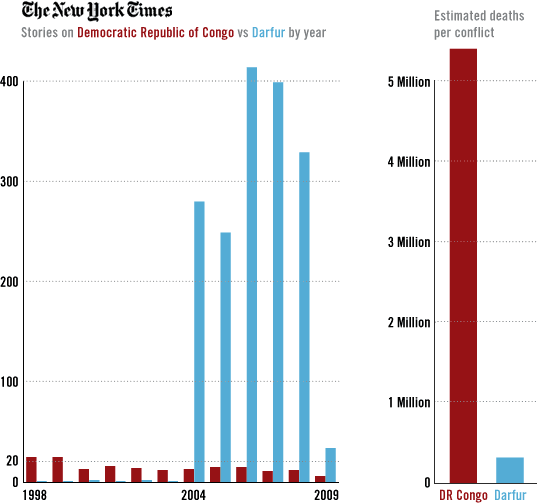25 February 2009
The Invisible War
On February 21, 2009 Bob Herbert published a column in the New York Times calling the war in the Democratic Republic of Congo “The Invisible War.” After a decade of bloodshed, millions killed and displaced, and an active UN peacekeeping force, why is Africa’s World War so invisible? He actually doesn’t speculate.
Perhaps Mr. Herbert should inquire at the editorial desk. Using the NY Times Article Search API I ran a query by year on the term “Democratic Republic of Congo.” The Times averaged 13.5 stories per year on DR Congo from 1998 through 2008. On the face of it, one story per month seems a nice steady focus. But by comparison, the Times published an average 151.6 stories on Darfur per year during the same period — even though the war in Darfur only started in 2003. In January 2008, the International Rescue Committee published a study reporting the war in DR Congo had claimed 5.4 million lives. In March 2008, the UN estimated the number of deaths in Darfur at 300,000.
Here are the counts of New York Times articles by year, as of February 24, 2009:
| 1998 | 1999 | 2000 | 2001 | 2002 | 2003 | 2004 | 2005 | 2006 | 2007 | 2008 | 2009 | |
| On DR Congo | 24 | 24 | 12 | 15 | 13 | 11 | 12 | 14 | 14 | 10 | 11 | 5 |
| On Darfur | 0 | 0 | 1 | 0 | 1 | 0 | 279 | 248 | 413 | 398 | 328 | 33 |
And a graphic I designed to illustrate it:

For those inclined, here’s the perl script I used to query the API. It borrows heavily from this example.
I realize one should be wary of comparing casualty data gathered with different methodologies, and that the conflict in DR Congo has a five year lead. But a million here, a million there, the disparity is still dramatic.
So why does Darfur get so much more coverage than DR Congo? Do the Arab Muslim bad guys in Sudan make a more convenient target for Western Islamophobes? Are China’s competing industrial interests in Sudan easier to finger than US corporate interests in DR Congo? Are the deserts of Darfur simply more accessible than the forests of Northeastern Congo? Or is Darfur a simpler story with clearer victims and perpetrators? A story closer to Western ideas of genocide than Congo’s messier regional war? Certainly the celebrity and NGO pressure on Darfur has helped. I should note that I’m emphatically not arguing that Darfur should be covered less, but that the war in DR Congo should be covered more. Much more.
Update 2/26/2009 — Anneke Van Woudenberg, Senior Researcher at Human Rights Watch sends this response:
“This comparison is both interesting and disturbing. In my ten years of working on Congo I have often wondered why it gets so much less press attention. The difficulties for journalists to get around and the expense of such trips contribute to the problem, but such problems also occur in Darfur or other conflicts that receive more press coverage. The complexities of the Congo conflict - the alphabet soup of armed groups and the constant changing alliances - make it a challenging story to cover. But it is not impossible. So what is it?
I fear that the Congo conflict receives less coverage because many outsiders have bought into the preconception that Congo is the ‘heart of darkness’ as characterized by Joseph Conrad's book by the same title. The book has often been used to refer to Congo’s plight today, as if the country is somehow predisposed to dark atrocities and violence, and hence there is nothing new to report. Yet many have misunderstood the real message of Conrad's book. It is not Congolese barbarism but rather the greed of outsiders that have plagued this country's history. As the narrator of Conrad's book describes, he found in Congo, ‘the vilest scramble for loot that ever disfigured the history of human conscience.’ A situation little changed today. Surely that story is worthy of further press coverage.”
Update 4/16/2009 — Julie Hollar at FAIR points out that The New York Times style does not always refer to DR Congo as “Democratic Republic of Congo,” rather sometimes just “Congo,” which makes the free text search problematic. Instead, I ran an API search for articles by geo tag, comparing documents tagged CONGO (FORMERLY ZAIRE) with documents tagged DARFUR (SUDAN).

By geo tag, Darfur still shows roughly double the coverage of DR Congo. Not quite as dramatic as my first graph, but still disproportionate. Of course this method depends on the Times for accurate tagging of their own articles. It’s unclear why a free text search for “Darfur” turns up so many more results than the geo tag search.
![]() 25 February 2009, 11:55 AM | LINK | Filed in
africa, information design, nytimes, war
25 February 2009, 11:55 AM | LINK | Filed in
africa, information design, nytimes, war
Read more items related by tag:

